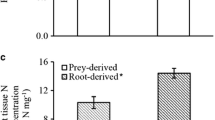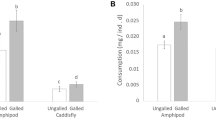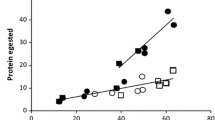Summary
Plants of Drosera species, neighbouring noncarnivorous plants, and arthropods on or near each Drosera sp. were collected at 11 contrasting habitat locations in SW Australia. At three of the sites clones of the rare glandless mutant form of D. erythrorhiza were collected alongside fully glandular counterparts. The δ 15N value (15N/14N natural isotope composition) of insect-free leaf and stem fractions was measured, and the data then used to estimate proportional dependence on insect N (%NdI) for the respective species and growth forms of Drosera. The data indicated lower %NdI values for rosette than for self-supporting erect or for climbing vine species. The latter two groups showed an average %NdI value close to 50%. The %NdI increased with length and biomass of climbing but not erect forms of Drosera. δ 15N values of stems were positively correlated with corresponding values for leaves of Drosera. Leaf material was on average significantly more 15N enriched than stems, possibly due to delayed transport of recent insect-derived N, or to discrimination against 15N in transfer from leaf to the rest of the plant. The comparison of δ 15N values of insects and arthropod prey, glandless and glandular plants of D. erythrorhiza indicated %NdI values of 14.3, 12.2 and 32.2 at the respective sites, while matching comparisons based on δ 15N of insect, reference plants and glandular plants proved less definitive, with only one site recording a positive %NdI (value of 10.4%) despite evidence at all sites of feeding on insects by the glandular plants. The use of the δ 15N technique for studying nutrition of carnivorous species and the ecological significance of insect feeding of different growth forms of Drosera growing in a large range of habitats is discussed.
Similar content being viewed by others
References
Aldenius J, Carlsson B, Karlsson S (1983) Effects of insect trapping on growth and nutrient content of Pinguicula vulgaris L. in relation to the nutrient content of the substrate. New Phytol 93:53–59
Ambrose SH, DeNiro MJ (1986) The isotope ecology of East African mammals. Oecologia 69:395–406
Chandler GE, Anderson JW (1976) Studies on the nutrition and growth of Drosera species with reference to the carnivorous habit. New Phytol 76:129–141
Darwin C (1875) Insektenfressende Pflanzen (translated by JV Carus), Schweizerbart'sche Verlagsbuchhandlung, Stuttgart
Dixon KW, Pate JS, Bailey WJ (1980) Nitrogen nutrition of the tuberous sundew Drosera erythrorhiza Lindl. with special reference to catch of arthropod fauna by its glandular leaves. Aust J Bot 28:283–297
Gebauer G, Schulze E-D (1991) Nitrogen and carbon isotope ratios in different compartments of a healthy and declining Picea abies forest in the Fichtelgebirge, NE Bavaria. Oecologia in press
Lowrie A (1987) Carnivorous plants of Australia. Vol. 1 University of Western Australia Press
Lüttge U (1983) Exophysiology of carnivorous plants. Encyc Plant Physiol NS 12C:489–517
Ofori F, Pate JS, Stern WR (1987) Evaluation of N2-fixation and nitrogen economy of a maize/cowpea intercrop system using 15N dilution methods. Plant Soil 102:149–160
Peterson BJ, Fry B (1987) Stable isotopes in ecosystem studies. Ann Rev Ecol Syst 8:293–320
Rundel PW, Ehleringer JR, Nagy KA (1989) (eds) Stable isotopes in ecological research. (Ecological Studies vol 68) Springer, Berlin Heidelberg New York
Schulze W, Schulze E-D (1990) Insect capture and growth of the insectivorous Drosera rotundifolia L. Oecologia 82:427–429
Shearer G, Kohl DH (1989) Estimates of N2 Fixation in Ecosystems: The need for and the basis of 15N Natural abundance method. In: Rundel PW, Ehleringer JR, Nagy KA (eds) Stable isotopesin ecological research (Ecological Studies vol 68) Springer, Berlin Heidelberg New York pp 342–375
Thum M (1988) The significance of carnivory for the fitness of Drosera in its natural habitat. 1. The reaction of Drosera intermedia and Drosera rotundifolia to supplementary feeding. Oecologia 75:472–480
Thum M (1989) The significance of carnivory for the fitness of Drosera in its natural habitat. 2. The amount of captured prey and its effect on Drosera intermedia and Drosera rotundifolia Oecologia 81:401–411
Virginia RA, Jarrell WM, Rundel PW, Shearer G, Kohl DH (1989) The use of variation in the natural abundance of 15N to assess symbiotic nitrogen fixation by woody plants. In: Rundel PW, Ehleringer JR, Nagy KA (eds) Stable isotopes in ecological research (Ecological Studies vol 68) Springer, Berlin Heidelberg New York, pp 375–394
Author information
Authors and Affiliations
Rights and permissions
About this article
Cite this article
Schulze, E.D., Gebauer, G., Schulze, W. et al. The utilization of nitrogen from insect capture by different growth forms of Drosera from Southwest Australia. Oecologia 87, 240–246 (1991). https://doi.org/10.1007/BF00325262
Received:
Accepted:
Issue Date:
DOI: https://doi.org/10.1007/BF00325262




